In the world of pollinators, honeybees take center stage. These popular insects dominate the headlines for all things pollinator-related. Although, quite literally, the buzz around town, honeybees aren’t actually the best pollinators out there. Contrary to popular belief, they’re not even among the best. Rather, there’s a much much bigger — and notably rounder — insect that reigns supreme in the battle of bee versus bee. The bee we’re talking about, of course, is the humble bumblebee.
Bumblebees: one-of-a-kind invertebrates
Bumblebees are large social insects that belong to the order, Hymenoptera. The order is a large one. It contains over 150,000 extant species and includes popular insects like ants, wasps, and bees. Although the closest living relatives of honeybees, bumblebees aren’t classified in the same genus as them. Honeybees belong to the genus, Apis. Bumblebees, on the other hand, are members of the genus, Bombus – the only extant genus under the tribe Bombini, a higher taxonomic classification that precedes the genus (akin to a sub-family).
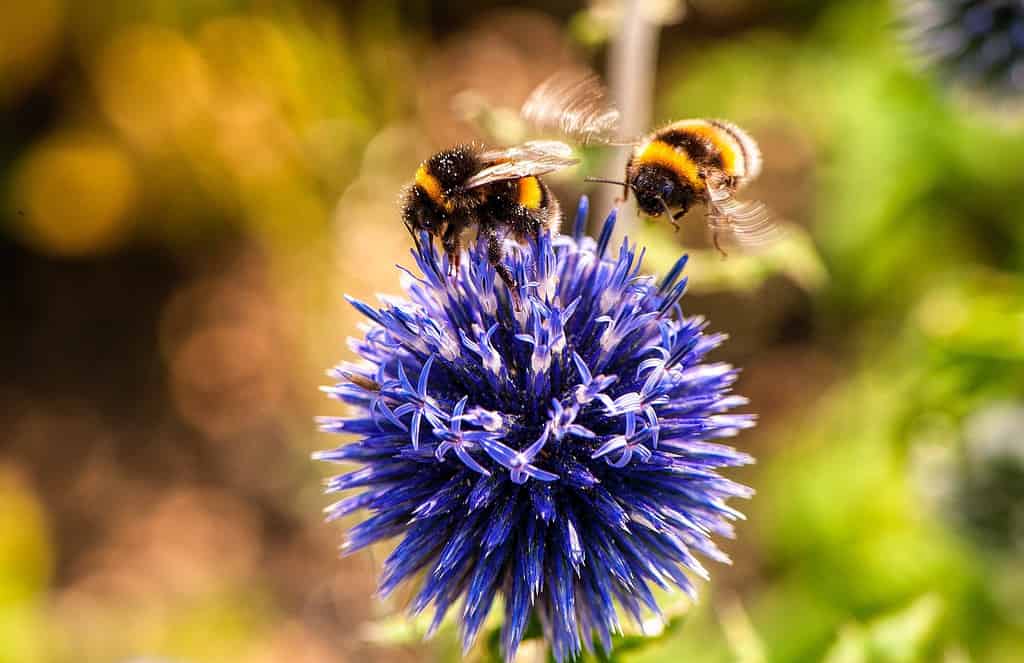
Similar to their taxonomy, even their distribution is limited
Everyone in the world knows a honeybee when they see one. Bumblebees, however, not so much. This is because, unlike Apids, bumblebees are not found all over the world. These insects prefer higher altitudes and naturally find themselves dispersed all over the temperate zones of the world. If you live along the equator or in the tropics, you’re less likely to come across one.

Fuzzballs in the sky
Like their industrious cousins — the honeybee — bumblebees also possess setae, tiny and soft hair-like structures that cover the entire length of their bodies. These setae, combined with the bumblebees’ round bodies, lend the invertebrates a very fuzzy and fluffy look. From a distance, these invertebrates just look like giant balls of fuzz in the sky.
Up close, however, things get much more intense. Measuring in at around one to three centimeters (about 0.6 to one inch), bumblebees are one of the largest bees in the world. Not only are bumblebees much larger than their cousins, but they’re also much louder. These hymenopterans have a very characteristic buzz to them.
Unless right by your face, honeybees make a very faint buzzing noise — it sounds a bit like a hum in the distance. Bumblebees, on the other hand, buzz like a phone on vibrate. The noise is much more noticeable. This electric cacophony isn’t just for show either.
Bumblebees buzz on a rather serious mission. Unlike honeybees and other smaller bees, bumblebees are very efficient pollinators. They’re able to extract the absolute maximum amount of pollen — plant sperm — out of the male parts of flowers. This efficiency comes down to their loud buzzing.
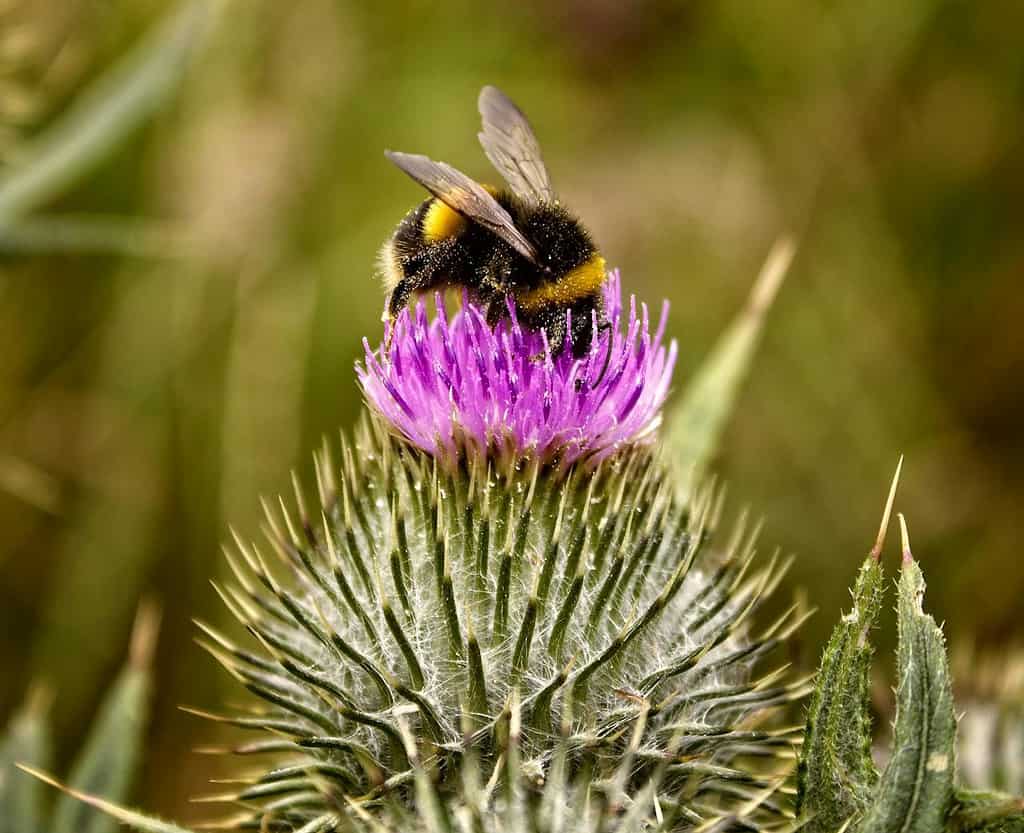
You see, the distinct buzz of just about any bee is generated by their rapid wingstroke. It’s the speedy back and forth of their wings that generate the loud vibrational noise we associate them with. However, in bumblebees, this vibrational noise isn’t just a byproduct of flight — but rather a surprisingly useful evolutionary advantage.
Buzz pollination
When a bumblebee lands on a flower laden with pollen, these guys, in a method known as scrabbling, use their jaws and legs to gather as much pollen as they possibly can.
Avery Russell, a biologist in the Department of Ecology and Evolutionary Biology, at the University of Arizona, described scrabbling, a foraging behavior of bees, in a press release.
“If you picture a happy toddler in a play pit filled with plastic balls, you get the idea of scrabbling,” said Avery.
However, when it comes to flowers in which pollen is much deeper embedded or scarce, bumblebees get a lot more creative. It’s here, in situations such as these, that these sneaky insects give their flight muscles another purpose.
These insects, after landing on a flower with little amounts of pollen, choose to engage in a particular form of pollination known as buzz pollination. Instead of using their jaws and legs to gather pollen, the invertebrates unfasten their wings from their flight muscles (yes, you read that right) so they can then vigorously shake and vibrate on the flower.
This aggressive shaking causes whatever pollen is inside the flower to fall out — onto the fuzzy body of the bee. After fastening back their wings, it’s just a matter of combing and collecting the pollen collected on their bodies back into their pollen collection baskets.
Large, fuzzy, loud…and scary?
All these factors: the size, the fuzz, and the noise, all give the bumblebee a bit of a bad rep. Due to their size and sound, it’s easy to assume bumblebees are dangerous. However, that isn’t the case. Bumblebees are foragers. It isn’t their natural tendency to attack anything — including humans.
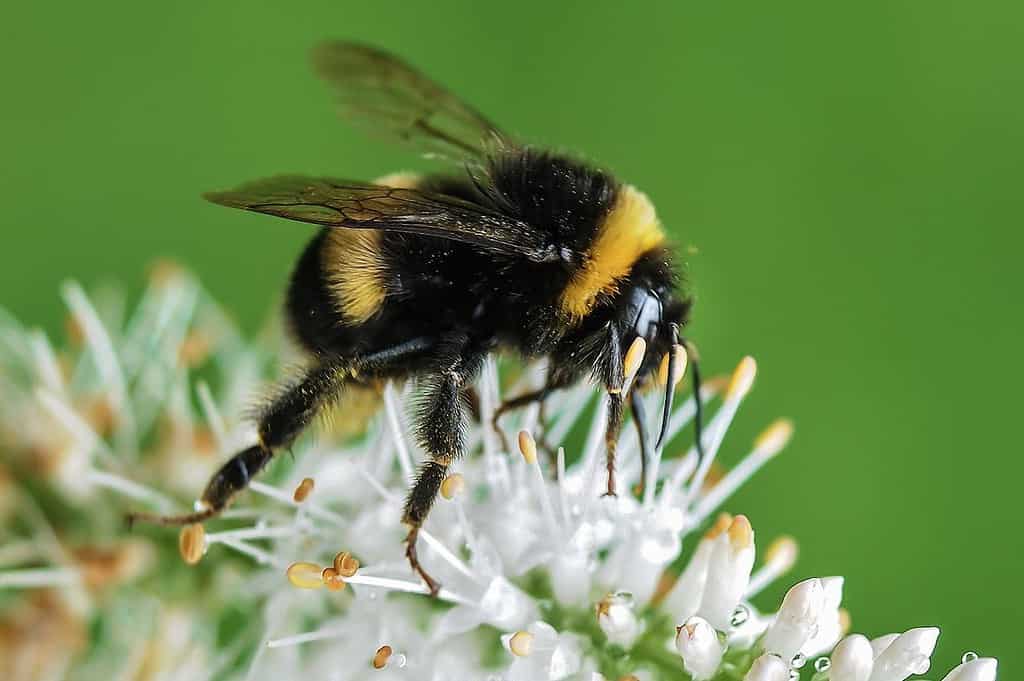
You’d be hard-pressed to even come across bumblebees. This is because these bees, unlike honeybees, nest underground. When they aren’t busy running behind nectar and pollen, they’re cooped up underground. Bumblebee colonies are also much smaller — often comprising anywhere between tens to just around 2,000 or so individuals. These numbers, in comparison to honeybee colonies — which comprise anywhere between 20,000 to hundreds of thousands of individuals — feel like petty change.
However, as highly social insects with an organized social structure and nest-building behaviors, they are highly defensive of their nests and will go on the offensive to protect their homes.
Can bumblebees sting?
Not all bumblebees can sting. Like wasps and hornets, only female bumblebees have a stinger. This stinger, a modified ovipositor — a tubular organ in the female reproductive system — is absent in males. This is because, unlike female bees, male bees have only one job: to mate.
Male bees, or drones, are born and raised with one sole objective: to fertilize the queen’s eggs. Unlike female worker bees, drones do not engage in tasks such as foraging, nursing the brood, or defending the hive. After mating, drones die, are expelled from the hive, or may not survive the winter.
Since males do not contribute to the defense of the hive, they don’t need to be armed with stingers. Females, on the other hand, do have a stinger — filled with venom — at the abdominal end of their bodies.
For hymenopterans like bumblebees, it isn’t instinct to strike at all things they see. They are foragers after all. However, they will use their stingers in situations that demand it — like self-defense.
Do bumblebees die after stinging?
Unlike their less fortunate cousins, bumblebees do not die if they sting something. This is because bumblebees, like the ancient wasps they evolved from, have smooth stingers; as opposed to jagged stingers.
Look below at this image of a honeybee’s stinger. Notice how the stinger is barbed? This barbed nature of the honeybee’s stinger is what eventually dooms them.
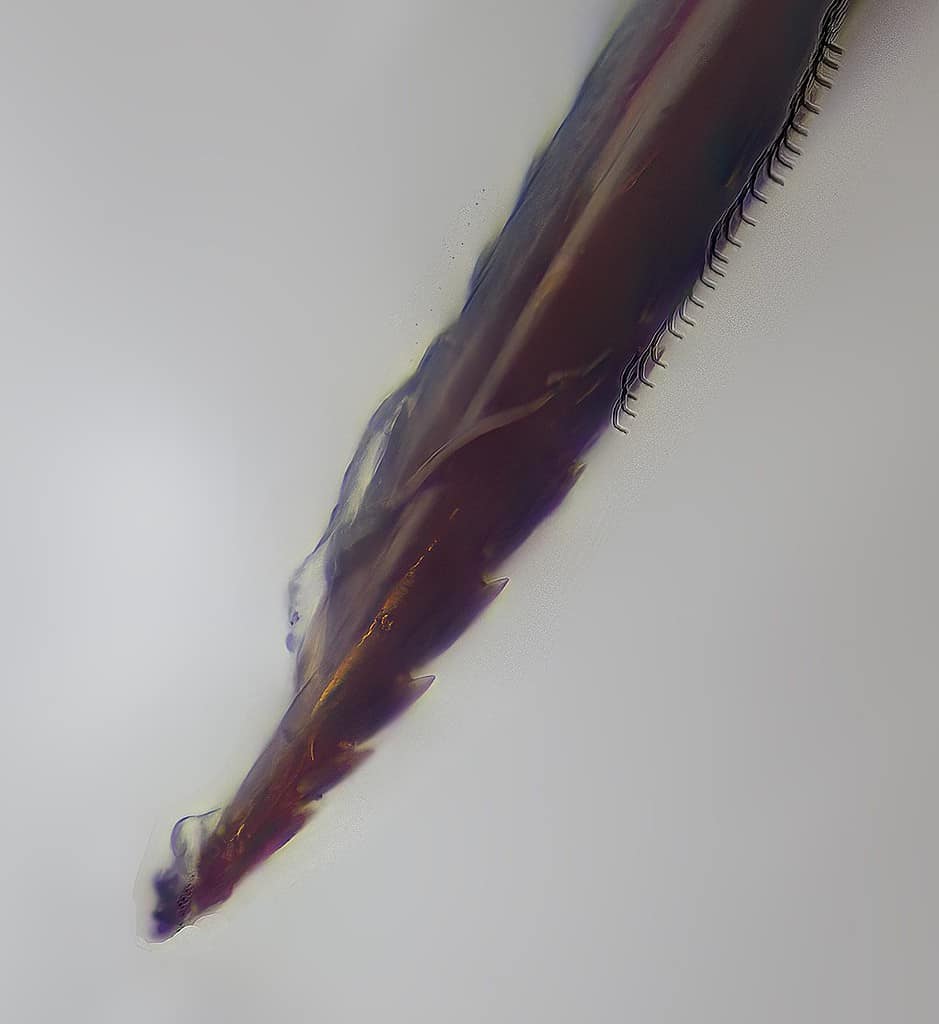
The jagged stinger of a honeybee is kind of similar to a deeply rooted splinter in one’s finger. Just as the slivers of a splinter make it hard and painful to remove, the jagged barbs of a honeybee’s stinger make extraction a stubborn, and eventually deadly process.
When these honeybees commit to self-defense and pierce at the skin of their perceived threat, like a human; they can’t take out the stinger without damage. This damage, however, causes the literal rupture of the bee’s entire lower abdomen.
When a honeybee stings you, it doesn’t just die — it severs itself into two pieces, losing a bunch of goop — entrails, musculature, glands, and a venom sac — in the process.
“It’s kind of like bleeding to death, except bees don’t have blood…it’s fake, clear insect blood,” said Eric Mussen, an apiculturist, told PBS NewsHour.
In contrast to honeybees, bumblebees don’t get too dramatic with their stinging. They’ve got smooth stingers — free of barbs. This lets them pierce the skins of their threats as many times as they’d like.
How dangerous is bumblebee venom?
Many hymenopteran insects, like bees, wasps, and ants, can produce venom. The exact stuff in the venom can vary among different species of hymenopterans, however, the venom generally contains similar biochemical components. From amino-acid-based molecules like enzymes and peptides, and fats like phospholipids, to protein-based antigens; hymenopteran venom is exceedingly complex.
Bumblebee venom is no exception. Generally, when stung by a bumblebee, one experiences intense and sharp-biting pain at the site of puncture. Generally, this reaction is localized. Any inflammatory response, like swelling and redness, is limited to the site of puncture — the response doesn’t extend to other faraway sites on the body.
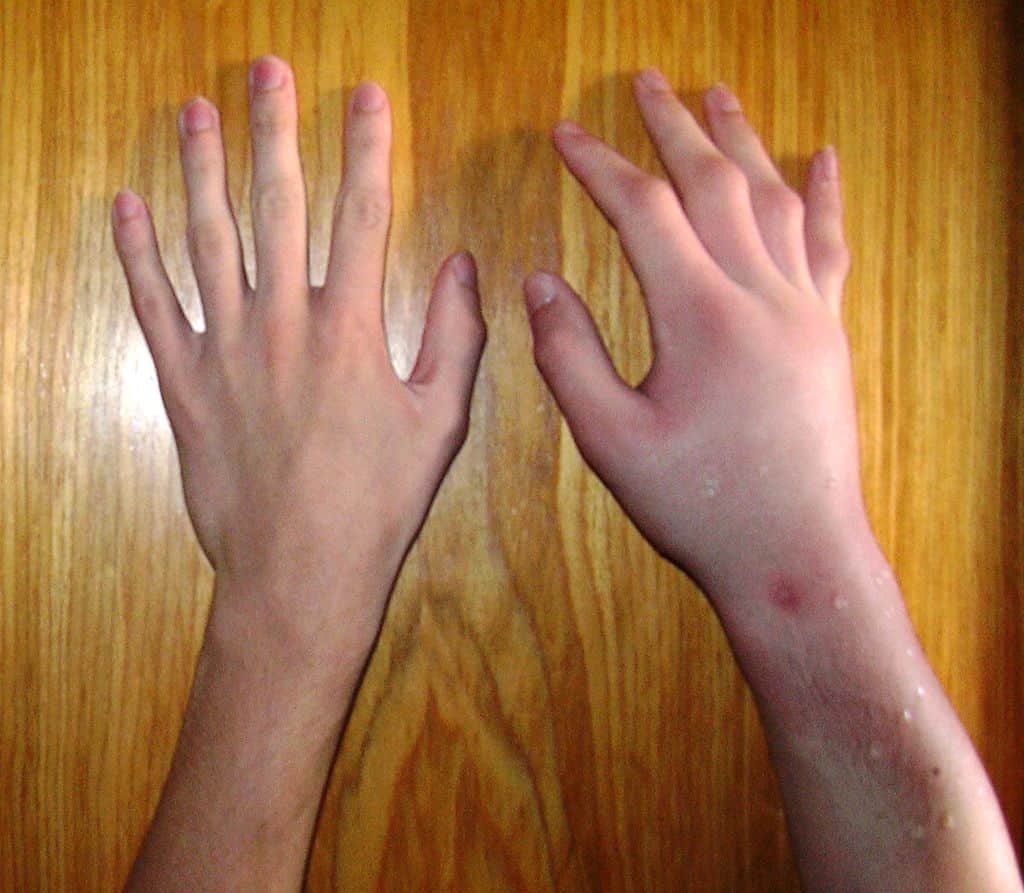
The reaction is also usually non-allergic. However, if you are allergic to bumblebee venom, the reaction can get adversely worse. Apart from the general symptoms of inflammation, individuals who are allergic to bumblebee venom also experience symptoms like nausea, dizziness, vomiting or diarrhea, and even swelling of the tongue or throat. This extreme reaction of the individual’s immune system is a severe allergic reaction — also known as anaphylaxis.
The four stages of anaphylaxis
Anaphylaxis symptoms differ from person to person. However, the reaction is generally classified into four steps, based on increasing severity. It’s important to be aware of the symptoms that characterize each stage.
Stage one
This is the least severe stage of an anaphylactic reaction. Usually, one exhibits mild inflammatory symptoms like redness, swelling, itching, and localized hives. Stage 1 allergic reactions tend to go down within a few hours.
Stage two
In this stage, In addition to stage 1 symptoms, one usually is affected by non-localized symptoms like abdominal pain and diarrhea, as well as a swelling of the face and its associated structures like the lips and tongue. These types of reactions generally tend to subside within five to ten days, if not quicker.
Stage three
Stage three and four reactions are generally considered severe allergic reactions. Besides the stage one and two symptoms, stage three symptoms range from a sudden drop in blood pressure, difficulties in breathing and chest pain, and sometimes, even a loss of consciousness.
Stage four
Stage four is the most severe, and dangerous stage of an anaphylactic reaction. In this stage, also called an anaphylactic shock, severe reactions have the potential to quickly progress to life-threatening conditions. Symptoms, like a weakening pulse, an acute drop in blood pressure, and even loss of blood flow all, contribute to a rapid deterioration of bodily functions. Stage four type reactions should always be taken seriously and immediate medical attention must be sought after in case any such symptoms do develop. Luckily, however, less than 1% of the population is allergic to Hymenopteran venom.
Recent research on bumblebee venom
Is bumblebee venom as dangerous as honeybee venom?
Compared to the venom of other hymenopterans, bumblebee venom is among the least toxic. This comes down to the fact that bumblebees produce very low amounts of major allergens or pain-producing factors, as compared to other species of hymenopterans social wasps, and honeybees.
Rather, bumblebee venom contains increased amounts of a particular antimicrobial peptide, defensin 1. This particular peptide comes in handy when maintaining their nests. Remember, unlike other bees, wasps, and hornets, bumblebees build their nests below the ground. Due to their underground location, defense isn’t a bumblebee’s biggest problem: it’s hygiene. This is reflected in their venom composition. Rather than using their venom for defense, they exploit it as a means to clean their nests.
Variation in bumblebee venom
Bumblebee venom doesn’t just differ from other hymenopteran venoms in terms of composition: it can also differ from bumblebee to bumblebee depending on where they live. In a study, conducted by researchers from the University of Lausanne and the Swiss Ornithological Institute, bumblebee venom exhibits plasticity — change — in composition, with elevation change. As part of their study, researchers sampled a particular species of bumblebee, the Bombus pascuorum, from a range of altitudes: 930 meters, 1360 meters, and 1700 meters.
The study, conducted in the picturesque western Swiss Alps, aimed to observe the change in venom composition with environmental factors, like an elevation gradient. And the team did just that. They were able to find that bumblebees who live at high altitudes produced a less potent venom.
In contrast, bumblebees that lived in lower altitudes, produced venom with increased amounts of PLA2, a protein sequence that contributes to venom toxicity. Thus, bees at lower altitudes produced a more toxic venom.

The researchers pinned this change in toxicity to several environmental factors. For instance, with an elevation change, variables like temperature and seasonality constantly change. Such factors have a direct impact on the habitat, as well as the behavior of the bumblebee.
The team also highlighted the role of predator-prey interactions as another possible answer as to why venom potency may gradually decrease with an increase in altitude. As elevation increases, predator pressure — that is the risk of being eaten by a predator — decreases. Essentially, at high altitudes bumblebee venom toxicity may decrease as they have fewer predators to defend against.
Conclusion
Although an allergy to hymenopteran venom is rare, it is exceedingly important to note that anyone can develop the allergy at any point in their life. This means that if you’ve been bitten by a bumblebee before and haven’t suffered an allergic reaction — you’re not guaranteed to get off scot-free the next time; so it’s best not to tempt fate.
How to prevent bumblebee stings?
There are a few things that help to prevent getting stung by bumblebees. For instance, if you’re out in the wild, it’s wise to wear full-sleeved clothes to better cover yourself up. Additionally, keep an eye out for any hives or nests and steer clear of them. It’s also wise to not swat or bump at bumblebees if one is hovering around you; rather just calmly remove yourself from the situation by walking away.
If you find yourself caught in an aggressive swarm of bees, already getting stung, it’s important to protect your mouth and nose, as getting stung near the two can close up your throat. Make sure to immediately get yourself to an inaccessible location — like inside a car or indoors. This is because once stung, bumblebees release a chemical to other bees in the vicinity. This signal acts as a beacon to attract other bees in the area to swarm around a perceived threat to the hive; in this case yourself.
It’s imperative to get out of the situation as quickly as possible. This is because multiple stings to the body can be just as bad — if not worse — than an allergic reaction. This is because multiple stings induce a toxic reaction in our bodies. This toxic reaction, rather than an allergic reaction, is caused by the accumulation of venom in our systems. This accumulation is what ends up making us sick. The reaction is characterized by symptoms ranging from vertigo, involuntary muscular spasms and contractions (convulsions), fever, nausea and headaches, vomiting, and even fainting.






